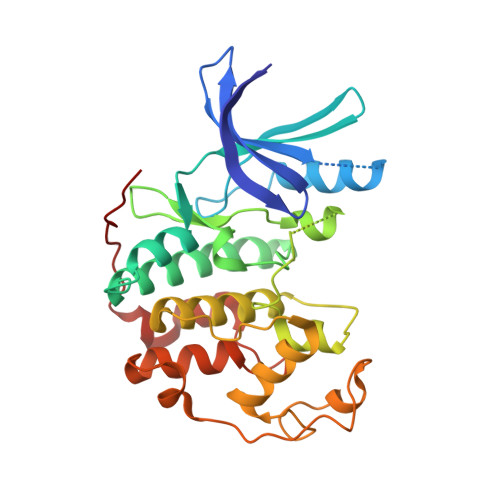Inhibitor Selectivity for Cyclin-Dependent Kinase 7: A Structural, Thermodynamic, and Modelling Study.
Hazel, P., Kroll, S.H., Bondke, A., Barbazanges, M., Patel, H., Fuchter, M.J., Coombes, R.C., Ali, S., Barrett, A.G., Freemont, P.S.(2017) ChemMedChem 12: 372-380
- PubMed: 28125165
- DOI: https://doi.org/10.1002/cmdc.201600535
- Primary Citation of Related Structures:
5JQ5, 5JQ8 - PubMed Abstract:
Deregulation of the cell cycle by mechanisms that lead to elevated activities of cyclin-dependent kinases (CDK) is a feature of many human diseases, cancer in particular. We identified small-molecule inhibitors that selectively inhibit CDK7, the kinase that phosphorylates cell-cycle CDKs to promote their activities. To investigate the selectivity of these inhibitors we used a combination of structural, biophysical, and modelling approaches. We determined the crystal structures of the CDK7-selective compounds ICEC0942 and ICEC0943 bound to CDK2, and used these to build models of inhibitor binding to CDK7. Molecular dynamics (MD) simulations of inhibitors bound to CDK2 and CDK7 generated possible models of inhibitor binding. To experimentally validate these models, we gathered isothermal titration calorimetry (ITC) binding data for recombinant wild-type and binding site mutants of CDK7 and CDK2. We identified specific residues of CDK7, notably Asp155, that are involved in determining inhibitor selectivity. Our MD simulations also show that the flexibility of the G-rich and activation loops of CDK7 is likely an important determinant of inhibitor specificity similar to CDK2.
- Section of Structural Biology, Department of Medicine, Imperial College London, South Kensington Campus, London, SW7 2AZ, UK.
Organizational Affiliation:

















